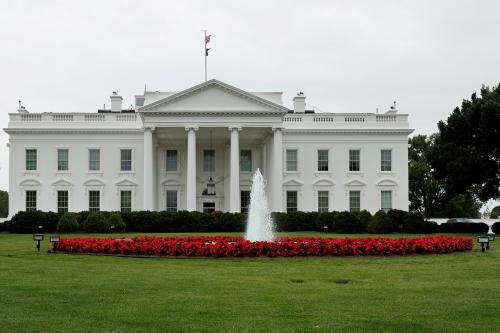The United States has a distinct opportunity to lead the world in rapid phase-down of a major climate pollutant, hydrofluorocarbons (HFCs) that pack an intensive short-term climate punch and are used widely in cooling systems such as air conditioning and refrigeration. In recent years, America has demonstrated leadership in technological development of climate-friendly alternatives and mustered broad political support to accelerate the HFC transition. This included bipartisan backing of 2020 legislation followed by overwhelming U.S. Senate support for a binding global treaty two years later.
The treaty, the Kigali Amendment to the Montreal Protocol on ozone-depleting substances, has been embraced by 150 nations—the latest extension of the most successful global environmental regime of the past half-century. Federal agencies have moved rapidly on implementation, issuing rules designed to achieve an 85% reduction in HFC production and use by the mid-2030s and launching a multi-agency task force to combat smuggling. Everything appeared to be in place for an exceptionally large global climate victory backed by a wide range of industries and governments led by the U.S.
There may, however, be one big catch. HFCs are easy to conceal in small containers, as Europe has experienced amid expanding smuggling activity. A federal court has now ruled that federal agencies lack the authority to combat smuggling by banning disposable containers for transporting coolant chemicals or deploying QR tracking codes to monitor their whereabouts.
Overshadowed by a flurry of recent high-profile Supreme Court rulings is a less salient but notable case from the D.C. Circuit of the U.S. Court of Appeals. It upholds Environmental Protection Agency (EPA) plans to address various HFC blends and allocate allowances through a cap-and-trade program in implementing the American Innovation and Manufacturing Act (AIM). But a majority opinion written by Judge Justin Walker (a Trump appointee) contends that “nowhere does the Act say anything about QR codes or refillable cylinders.” As a result, two linchpins in federal efforts to deter HFC smuggling have been removed, raising significant questions about AIM and Kigali implementation.
The Walker opinion, supported by Judge Karen LeCraft Henderson (a G.H.W. Bush appointee), focuses on the lack of specific statutory reference to the technologies in question. It views HFC regulation exclusively in domestic policy terms, making no reference to Kigali or cross-border smuggling. It defines AIM provisions that EPA “shall ensure” compliance very narrowly, describing its phase-down schedule as “a math equation, not a grant of regulatory power.”
In a partial dissent, Judge Nina Pillard (an Obama appointee), offers a profoundly different view. She characterizes the cannister and code provisions as examples of appropriate agency interpretation of statute. Pillard reviews Kigali and cross-border trade in cooling chemicals as well as EPAs lengthy history in setting container and labeling requirements for such substances as pesticides and biofuels. The majority opinion “will hamstring EPA’s efforts to combat illicit trade in HFCs,” she writes, “making it less likely that the United States accomplishes the HFC reductions Congress mandated.”
This case did not rise to “major question” status, but nonetheless demonstrates the far-reaching capacity of federal courts to block agency interpretation of statutes. The rejected provisions could possibly be restored through separate rules under development, although that would likely face further judicial scrutiny. Congress also could rewrite the AIM Act to specify its views more precisely on container and code use, but legislative revision of existing environmental law has been extremely rare for decades. With a divided Congress, passing a new bill through both the House and the Senate would be challenging.
What appears more likely is that the U.S. may squander an opportunity to lead globally on reducing releases of a major climate contaminant, despite a process that navigated the political gauntlet and yielded a remarkably brief but clear piece of legislation and then broad treaty support. The European Union and other early actors are intensifying their own efforts to deter smuggling, including border seizures, customs agent scanning, and refillable container bans, sustaining early leadership while the U.S. sorts things out.
There are also potential challenges ahead for American manufacturers of HFC alternatives, including expanded competitive risks from illegally produced HFCs. Failure to establish a viable international system will have clear climate consequences in a world in which 10 new air conditioners are purchased globally every second. Full, international Kigali implementation would reduce global temperatures 0.5 degrees Celsius by the end of this century, a cornerstone in climate protection.
This case may foreshadow further judicial micro-management of agency efforts to interpret statutes, including future cases where technology is emerging to achieve significant environmental and climate gains. Like HFCs, methane is also a major short-lived climate pollutant for which the United States appears poised to accelerate mitigation. However, opportunities to take advantage of rapid technological advances to monitor releases precisely from satellites, planes, and drones or to capture gases before release could be undermined if Congress fails to specify in painstaking detail its views on the roles of such technologies in legislation.
The decision also underscores the imperative to restore the U.S. Office of Technology Assessment (OTA). As my Brookings colleague Darrell West has noted, OTAs demise in the 1990s has impaired congressional capacity to understand and address a wide range of technology-related issues. If Congress must spell out in legislation detailed rationales and instructions for federal agencies to deploy single use cannisters and QR codes for cooling sector chemicals, we may be entering a new era whereby the legislative branch will need to markedly expand its technological expertise if future legislation is to survive judicial muster and be effective. OTA restoration could begin to bolster congressional capacity to assume such responsibilities.
The Brookings Institution is committed to quality, independence, and impact.
We are supported by a diverse array of funders. In line with our values and policies, each Brookings publication represents the sole views of its author(s).








Commentary
Court limits technology use in climate protection case
July 27, 2023